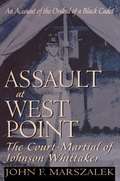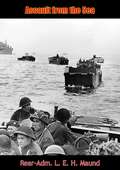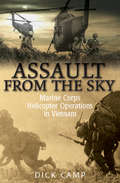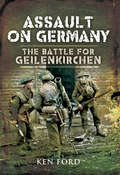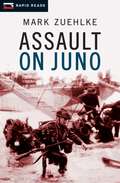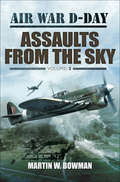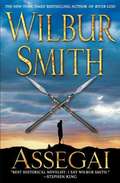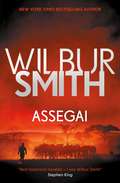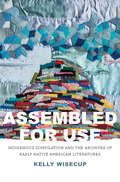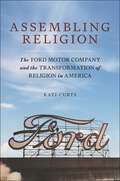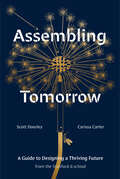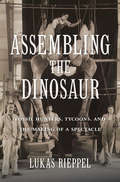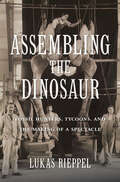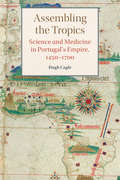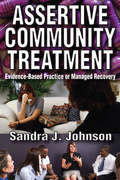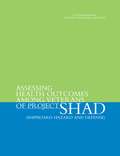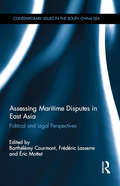- Table View
- List View
Assault at West Point, The Court Martial of Johnson Whittaker
by John MarszalekIn "Assault at West Point", John F. Marszalek, the highly acclaimed author of "Sherman: A Soldier's Passion for Order", has written a dramatic account of one of the most momentous trials in American history. Set in the 1880s, this riveting story focuses on Whittaker, a former slave who became the third black to enter West Point. Like his two predecessors, he was ostracized for the entire three years of his training. One morning Whittaker didn't show up for drill. He was found in his room, unconscious, tied tightly to the bed, with blood streaming from his head. In a trial that received major attention from the press, Whittaker was accused of faking the crime to get sympathy from the public and from his professors. Author Marszalek weaves his rich narrative from historical records to tell how Whittaker sought justice against all odds. Now the basis if the Showtime original movie "Assault at West Point", this compelling work brings to life a case that rocked the country and involved the highest reaches of power-- and vividly demonstrates the impact of racism on the fabric of American society.
Assault at West Point: The Court Martial of Johnson Whittaker
by John F. MarszalekIn "Assault at West Point", John F. Marszalek, the highly acclaimed author of "Sherman: A Soldier's Passion for Order", has written a dramatic account of one of the most momentous trials in American history. Set in the 1880s, this riveting story focuses on Whittaker, a former slave who became the third black to enter West Point. Like his two predecessors, he was ostracized for the entire three years of his training. One morning Whittaker didn't show up for drill. He was found in his room, unconscious, tied tightly to the bed, with blood streaming from his head. In a trial that received major attention from the press, Whittaker was accused of faking the crime to get sympathy from the public and from his professors. Author Marszalek weaves his rich narrative from historical records to tell how Whittaker sought justice against all odds. Now the basis if the Showtime original movie "Assault at West Point", this compelling work brings to life a case that rocked the country and involved the highest reaches of power-- and vividly demonstrates the impact of racism on the fabric of American society.
Assault from the Sea
by Merrill L. BartlettThis collection of 51 essays provides a history of amphibious landings that include European, Asian, and American operations. It describes in detail some of history's most significant amphibious assaults, as well as planned attacks that were never carried out.
Assault from the Sea
by Rear-Adm. L. E. H. MaundAssault from the Sea, first published in 1949, is Rear-Admiral Maund’s account of the development of the Royal Navy’s landing craft and their use operationally between 1939 and 1945.“It is the purpose of this book to show how this knowledge and equipment were gradually collected. It starts in the days before the last war, when most people thought landing operations would be impossible, and traces their development to the days of the great awakening at Dunkirk and on to present times. It shows how developments in material, tactics and planning were evolved by original thought, training, planning operations and experiments and it indicates the influence of political and strategic considerations upon this development.”—Preface
Assault from the Sky: Marine Corps Helicopter Operations in Vietnam
by Dick Camp&“Action-packed . . . he brings the reader artfully through the fog of war with clarity&” (20th Century Aviation Magazine). Vietnam has often been called our &“first helicopter war,&” and indeed, the US Marine Corps, as well as Army, had to feel its way forward during the initial combats. But by 1967, the combat was raging across South Vietnam, with confrontational battles against the NVA on a scale comparable to the great campaigns of WWII. In 1968, when the Communists launched their mammoth counteroffensive, the Marines were forced to fight on all sides, with the helicopter giving them the additional dimension that proved decisive in repelling the enemy. The author of this book, a Vietnam veteran and Purple Heart recipient who has also worked at the USMC History Division and National Museum of the Marine Corps in Quantico, uses his experiences as a company commander to bring the story to life by weaving personal accounts, after-action reports, and official documents into a compellingly readable narrative of service and sacrifice by Marine pilots and crewmen. The entire story of the war is depicted through the prism of Marine helicopter operations, from the first deployments to support the Army of the Republic of Vietnam against the Viet Cong through the rapid US buildup to stop the North Vietnamese Army, until the final withdrawal from our Embassy. &“Superlative research.&” —Leatherneck
Assault on Germany: The Battle for Geilenkirchen
by Ken FordThe author of A Luftwaffe General gives a detailed history of the Allied forces&’ brutal Operation Clipper during World War II. The Anglo-American battle for the Geilenkirchen salient in November, 1944, was infantry warfare at its worst, and it is described in vivid detail in this new edition of Ken Ford&’s classic study. The onset of winter saw the Allied advance from the Normandy beaches forced to a halt on Germany&’s doorstep. The clock had been put back to the days of the Great War—the Allies had arrived at the Siegfried Line and were forced to attack the fortifications from the hell of the trenches. Geilenkirchen was the first battle on German soil to be fought by the British since Minden in 1759. For them, it was just one more battle on the way to Berlin, but for the American 84th Division, it was a first faltering step into war and a bitter lesson in the attrition and savagery of combat. The story is told by the men who were there—the British, the Americans, and the Germans who were fighting desperately for their homeland. Neither side was victorious—both lost more men than they could afford and paid a heavy price in young lives for a few miles of ground.
Assault on Juno (Rapid Reads)
by Mark ZuehlkeDawn, June 6, 1944. Off the Normandy coast 6,500 ships carry 150,000 Allied troops. This is D-Day, the long-awaited Allied invasion of German-occupied Europe. The Allies will storm five beaches. One is code-named Juno Beach. Here, 14,500 Canadians will land on a five-mile stretch of sand backed by three resort towns. The beach is heavily protected by a seawall, barbed wire, underwater obstacles and hundreds of mines. Behind these defenses a heavily armed German force waits inside thick concrete pillboxes and deep trenches that bristle with machineguns and artillery pieces. About 3,500 Canadians will lead the way. The fate of the invasion is in their hands. They either break the German defenses or die trying. Piling out of small, frail landing craft, they struggle through bullet- and shell-whipped water to gain the sand. And the bloody battle for Juno Beach begins. With his trademark you-are-there style, acclaimed military historian Mark Zuehlke plunges readers into a vivid and powerful account of the day-long battle that put the Allies on the march toward victory in World War II.
Assaults from the Sky: Assaults From The Sky (Air War D-Day #2)
by Martin W. BowmanThis is the second volume of a comprehensive five part work on D-Day that includes a multitude of personal military accounts from both Allied and German Aviation personnel who were there. Overlord began with an assault by more than 23,000 airborne troops, 15,500 of them American, behind enemy lines to soften up the German troops and to secure key objectives. 6,600 paratroopers of the US 101st Screaming Eagles Division in 633 C-47s and 83 gliders and 6,396 paratroopers of the US 82nd All American Division in 1,101 C-47s and 427 gliders were dropped over the neck of the Cotentin peninsula. By the end of the operation, the list of casualties was extensive. But 101st Airborne Division linked up with the US 4th Infantry Division beach landings at Pouppeville, the most southerly exit off Utah Beach and the 82nd secured the area north of Ste-Mre-glise after fierce fighting and drove the enemy north, considerably delaying the German 243rd Infantry Division from contacting the Allied beach assault force. This important episode within the wider history of D-Day is enlivened in classic Bowman fashion, featuring both extensive historical notes as well as deeply personal accounts of endurance and individual gallantry.
Assedio del Cuore (Romanticismo della Guerra del Sud #2)
by Lexy TimmsKnox Township, 1863 Assedio del Cuore, Libro 2 della serie Romanticismo Merdionale, dell'autrice di best seller Lexy Timms. Jasper Perry ha una casa, una famiglia - tutto quello che lui pensava fosse perso per sempre dopo l'inizio della guerra.Con l'amore di Clara, Jasper crede di avere tutto quello che voleva. Mentre aspetta di sposarsi con Clara, lui scopre di aver6e superato la nostelgia di casa. Quando una milizia Confederata lo rapisce, determinato a punirlo per la sua defezione, Jasper ha una scelta: rinunciare alla lealtà che una volta aveva nei confronti della Confederazione e combattere per tornare indietro da Clara; oppure lasciare la sua nuova casa alle spalle, per tornare verso tutto ciò che è familiare. Per rendere le cose più complicate, la milizia ha scambiato Cecelia per la moglie di Jasper, e l'ha rapita. Riunito con la sua famiglia, Solomon Dalton tenta di ritornare alla sua vecchia vita come se nulla fosse accaduto. Ma quando Jasper e Cecelia sono rapiti, Solomon deve ritornare nel territorio della Confederazione per salvare le persone che ama. Ad ogni modo, lui non è solo, un uomo strano lo sta seguendo, e Solomon ha udito sottoforma di calmi sussurri che spie dell'Unione stanno cercando le persone che hanno tradito la causa...
Assegai
by Wilbur SmithWilbur Smith has won acclaim worldwide as the master of the historical novel. Now, in Assegai he takes readers on an unforgettable African adventure set against the gathering clouds of war. It is 1913 and Leon Courtney, an ex-soldier turned professional hunter in British East Africa, guides the rich and powerful from America and Europe on big-game safaris. Leon had never sought fame, but an expedition alongside U.S. President Theodore Roosevelt has made him one of the most sought-after hunters on the continent. Soon, he finds that with celebrity comes not just wealth--but also danger. Leon is recruited by his uncle Penrod Ballantyne, commander of the British forces in East Africa, to gather information on one of his clients: Count Otto von Meerbach, a German industrialist whose company builds aircraft and vehicles for the Kaiser's burgeoning army. While spying, Leon falls desperately in love with von Meerbach's beautiful and enigmatic mistress, Eva von Wellberg. On the eve of the World War, Leon stumbles on a plot by Count von Meerbach that could wipe out the British forces in Africa. He finds himself left alone to frustrate von Meerbach's plan, and in grave peril as he learns more about the enigmatic Eva. Set amidst the tensions that will spark a war across continents, Assegai delivers the fast-paced action and vivid history that has made Wilbur Smith an internationally bestselling author.
Assegai: The Courtney Series 13 (The Courtney Series: The Assegai Trilogy #1)
by Wilbur SmithA Courtney series adventure - Book 1 in the Assegai sequenceFor King and Country. No matter the cost. With the backing of his uncle, General Penrod Ballantyne, young Leon Courtney joins the King's Rifles of Nairobi. When he becomes discouraged by the dishonesty of army life, his uncle recruits him for a special mission - spying on the Germans in East Africa, whom the General suspects are preparing for the Kaiser's war. Posing as a professional game hunter Leon is tasked with gathering information on one is his clients, a wealthy industrialist Otto Von Meerbach. Leon finds himself falling for von Meerbach's beautiful mistress but never forgets that his real mission is to destroy the enemy. But how easy will he find his task when his true enemy is closer to home than Leon ever expected?
Assembled for Use: Indigenous Compilation and the Archives of Early Native American Literatures (The Henry Roe Cloud Series on American Indians and Modernity)
by Kelly WisecupA wide-ranging, multidisciplinary look at Native American literature through non-narrative texts like lists, albums, recipes, and scrapbooks &“An intricate history of Native textual production, use, and circulation that reshapes how we think about relationships between Native materials and settler-colonial collections.&”—Rose Miron, D&’Arcy McNickle Center for American Indian and Indigenous Studies at the Newberry Library Kelly Wisecup offers a sweeping account of early Native American literatures by examining Indigenous compilations: intentionally assembled texts that Native people made by juxtaposing and recontextualizing textual excerpts into new relations and meanings. Experiments in reading and recirculation, Indigenous compilations include Mohegan minister Samson Occom&’s medicinal recipes, the Ojibwe woman Charlotte Johnston&’s poetry scrapbooks, and Abenaki leader Joseph Laurent&’s vocabulary lists. Indigenous compilations proliferated in a period of colonial archive making, and Native writers used compilations to remake the very forms that defined their bodies, belongings, and words as ethnographic evidence. This study enables new understandings of canonical Native writers like William Apess, prominent settler collectors like Thomas Jefferson and Henry Rowe Schoolcraft, and Native people who contributed to compilations but remain absent from literary histories. Long before current conversations about decolonizing archives and museums, Native writers made and circulated compilations to critique colonial archives and foster relations within Indigenous communities.
Assembled in Japan: Electrical Goods and the Making of the Japanese Consumer
by Simon PartnerAssembled in Japan investigates one of the great success stories of the twentieth century: the rise of the Japanese electronics industry. Contrary to mainstream interpretation, Simon Partner discovers that behind the meteoric rise of Sony, Matsushita, Toshiba, and other electrical goods companies was neither the iron hand of Japan's Ministry of International Trade and Industry nor a government-sponsored export-led growth policy, but rather an explosion of domestic consumer demand that began in the 1950s.This powerful consumer boom differed fundamentally from the one under way at the same time in the United States in that it began from widespread poverty and comparatively miserable living conditions. Beginning with a discussion of the prewar origins of the consumer engine that was to take off under the American Occupation, Partner quickly turns his sights on the business leaders, inventors, laborers, and ordinary citizens who participated in the broadly successful effort to create new markets for expensive, unfamiliar new products.Throughout, the author relates these pressure-cooker years in Japan to the key themes of twentieth-century experience worldwide: the role of technology in promoting social change, the rise of mass consumer societies, and the construction of gender in advanced industrial economies.
Assembling Religion: The Ford Motor Company and the Transformation of Religion in America
by Kati CurtsHow Henry Ford institutionalized a social gospelHenry Ford did not just mass produce cars. As a member of the Episcopal Church, reader of New Thought texts, believer in the “gospel of reincarnation,” mass marketer of antisemitic material, and employer who institutionalized a social gospel, Henry Ford’s contributions to American models of business were informed by and produced for an America he understood to be broadly Christian. Though Ford’s efforts at the head of the Ford Motor Company have commonly been understood as secular, Ford himself was explicit that his work in engineering and auto production was prophetic and meant to remake the world.This religious history of Henry Ford and the Ford Motor Company repositions them within critical studies of religion, examining how Ford transformed American religious practice in the twentieth century. Drawing directly on documents from Ford’s archive, it examines Ford’s mass production methods and bureaucratic reforms as examples of prosperity gospel traditions, illuminating the ways manufacturing and technology intersect with American religious practice. Bridging American religious and industrial history, Assembling Religion offers a new and surprising way to understand Ford’s impact on culture, commerce, and the technology of labor.
Assembling Tomorrow: A Guide to Designing a Thriving Future from the Stanford d.school (Stanford d.school Library)
by Scott Doorley Stanford d.school Carissa CarterA powerful guide to why even the most well-intentioned innovations go haywire, and the surprising ways we can change course to create a more positive future, by two celebrated experts working at the intersection of design, technology, and learning at Stanford University&’s acclaimed d.school.&“This brilliant book offers a new approach to all creative work that will expand your understanding of what it means to make and open up possibilities you didn&’t know existed—it did for me.&”—Adam Johnson, Pulitzer Prize-winning author of The Orphan Master&’s SonIn Assembling Tomorrow, authors Scott Doorley and Carissa Carter explore the intangible forces that prevent us from anticipating just how fantastically technology can get out of control, and what might be in store for us if we don&’t start using new tools and tactics. Despite our best intentions, our most transformative innovations tend to have consequences we can&’t always predict. From the effects of social media to the uncertainty of AI and the consequences of climate change, the outcomes of our creations ripple across our lives. Time and again, our seemingly ceaseless capacity to create rubs up against our limited capacity to understand our impact. Assembling Tomorrow explores how to use readily accessible tools to both mend the mistakes of our past and shape our future for the better. We live in an era of &“runaway design,&” where innovations tangle with our lives in unpredictable ways. This book explores the off-kilter feelings of today and follows up with actionables to alter your perspective and help you find opportunities in these turbulent times. Mixed throughout are histories of the future, short pieces of speculative fiction that imagine the future as if it has already happened and consider the past with a critical yet hopeful eye so that all of us—as designers of our own futures—can create a better world for generations to come.
Assembling the Dinosaur: Fossil Hunters, Tycoons, and the Making of a Spectacle
by Lukas RieppelLukas Rieppel shows how dinosaurs gripped the popular imagination and became emblems of America’s industrial power and economic prosperity during the Gilded Age. Spectacular fossils were displayed in museums financed by North America’s wealthiest tycoons, to cement their reputation as both benefactors of science and fierce capitalists.
Assembling the Dinosaur: Fossil Hunters, Tycoons, and the Making of a Spectacle
by Lukas RieppelA lively account of the dinosaur’s role in Gilded Age America, examining the connection between business, paleontology, and museums.Although dinosaur fossils were first found in England, a series of dramatic discoveries during the late 1800s turned North America into a world center for vertebrate paleontology. At the same time, the United States emerged as the world’s largest industrial economy, and creatures like Tyrannosaurus, Brontosaurus, and Triceratops became emblems of American capitalism. Large, fierce, and spectacular, American dinosaurs dominated the popular imagination, making front-page headlines and appearing in feature films.Assembling the Dinosaur follows dinosaur fossils from the field to the museum and into the commercial culture of North America’s Gilded Age. Business tycoons like Andrew Carnegie and J. P. Morgan made common cause with vertebrate paleontologists to capitalize on the widespread appeal of dinosaurs, using them to project American exceptionalism back into prehistory. Learning from the show-stopping techniques of P. T. Barnum, museums exhibited dinosaurs to attract, entertain, and educate the public. By assembling the skeletons of dinosaurs into eye-catching displays, wealthy industrialists sought to cement their own reputations as generous benefactors of science, showing that modern capitalism could produce public goods in addition to profits. Behind the scenes, museums adopted corporate management practices to control the movement of dinosaur bones, restricting their circulation to influence their meaning and value in popular culture.Tracing the entwined relationship of dinosaurs, capitalism, and culture during the Gilded Age, Lukas Rieppel reveals the outsized role these giant reptiles played during one of the most consequential periods in American history.Praise for Assembling the Dinosaur“A penetrating study of legitimacy and capitalism in the realm of fossils.” —Verlyn Klinkenborg, The New York Review of Books“A solid entry into the growing body of literature on Gilded Age American paleontology, but it is particularly valuable for its contribution to enhancing our understanding of how science and its representation during that period were influenced by, and in turn affected, society as a whole. By incorporating cultural, economic, and scientific developments, Rieppel shines new light on the history of both American paleontology and museum exhibition practice.” —Ilja Nieuwland, Science
Assembling the Tropics: Science and Medicine in Portugal's Empire, 1450–1700 (Studies in Comparative World History)
by Hugh CagleFrom popular fiction to modern biomedicine, the tropics are defined by two essential features: prodigious nature and debilitating illness. That was not always so. In this engaging and imaginative study, Hugh Cagle shows how such a vision was created. Along the way, he challenges conventional accounts of the Scientific Revolution. The history of 'the tropics' is the story of science in Europe's first global empire. Beginning in the late fifteenth century, Portugal established colonies from sub-Saharan Africa to Southeast Asia and South America, enabling the earliest comparisons of nature and disease across the tropical world. Assembling the Tropics shows how the proliferation of colonial approaches to medicine and natural history led to the assemblage of 'the tropics' as a single, coherent, and internally consistent global region. This is a story about how places acquire medical meaning, about how nature and disease become objects of scientific inquiry, and about what is at stake when that happens.
Assembly by Design: The United Nations and Its Global Interior (Buell Center Books in the History and Theory of American Architecture)
by Olga TouloumiHow the United Nations headquarters became the architectural instrument and broadcast medium of global diplomacy For almost seven years after World War II, a small group of architects took on an exciting task: to imagine the spaces of global governance for a new political organization called the United Nations (UN). To create the iconic headquarters of the UN in New York City, these architects experimented with room layouts, media technologies, and design in tribunal courtrooms, assembly halls, and council chambers. The result was the creation of a new type of public space, the global interior. Assembly by Design shows how this space leveraged media to help the UN communicate with the world. With its media infrastructure, symbols, acoustic design, and architecture, the global interior defined political assembly both inside and outside the UN headquarters, serving as the architectural medium to organize multilateral encounters of international publics around the globe. Demonstrating how aesthetics have long held sway over political work, Olga Touloumi posits that the building framed diplomacy on the ground amid a changing political landscape that brought the United States to the forefront of international politics, destabilizing old and establishing new geopolitical alliances. Uncovering previously closed institutional and family archives, Assembly by Design offers new information about the political and aesthetic decisions that turned the UN headquarters into a communications organism. It looks back at a moment of hope, when politicians, architects, and diplomats—believing that assembly was a matter of design—worked together to deliver platforms for global democracy and governance.
Asser's Life of King Alfred
by AsserAlfred the Great (848 - 899) was a king in West Saxon and then the first king of the Anglo-Saxons, king of Britain. He spent his early career fighting Viking invasions, until in 878 he won a decisive victory against them, and then personally oversaw the conversion of the Viking leader to Christianity. He left a legacy for being gracious, rational, peaceable, and generally working to improve the overall quality of people's lives. This biography was composed by Asser (d. 909), a Welsh monk and later bishop.-Print ed.
Asser's Life of King Alfred, Together with the Annals of Saint Neots
by William Henry StevensonAsser (died c. 909) was a Welsh monk from St David's, Dyfed, who became Bishop of Sherborne in the 890s. About 885 he was asked by Alfred the Great to leave St David's and join the circle of learned men whom Alfred was recruiting for his court. After spending a year at Caerwent because of illness, Asser accepted.In 893 Asser wrote a biography of Alfred, called the Life of King Alfred. The manuscript survived to modern times in only one copy, which was part of the Cotton library. That copy was destroyed in a fire in 1731, but transcriptions that had been made earlier, together with material from Asser's work which was included by other early writers, have enabled the work to be reconstructed. The biography is the main source of information about Alfred's life and provides far more information about Alfred than is known about any other early English ruler. Asser assisted Alfred in his translation of Gregory the Great's Pastoral Care, and possibly with other works.
Assertive Community Treatment: Evidence-based Practice or Managed Recovery
by Sandra JohnsonThe twenty-first century has witnessed an explosion in studies on comparative health studies, but mental health remains virtually ignored. Unlike the well researched topic of health policy, there is a gap in the marketplace covering mental health policy and health care policymaking. This book fills that gap; it is a comparative analysis of the implementation of Assertive Community Treatment (ACT), an evidence-based practice employed in two states that promises to empower the well-being of individuals suffering from mental illness.Assertive Community Treatment specifically examines the tension separating the notion of client recovery and evidence-based programs. Johnson challenges the assumption that practitioners should rely on evidence-based practices to close the gap between scientific knowledge and practice. She argues that in an era of managed care, this encourages state mental health administrators to adopt policies that are overly focused on outcomes. Programs that can measure the outcomes of care provided, and evidence-based practices, have become central aspects of the quality care agenda.This study traces the role of policy entrepreneurs throughout the Assertive Community Treatment policymaking process. By differentiating mental health in general, qualitative research increases the chances of observing similarities and differences in outcomes. Johnson explains why the ACT model was adopted and implemented. She concludes that there is a clear monopoly by medical researchers and scientists within Assertive Community Treatment research, and as a result, too much emphasis is placed on the roles of policy entrepreneurs as the main innovators in the agenda and policy formulation stages. Johnson presents a strong argument for more innovation in the implementation stage.
Assessing China's Naval Power: Technological Innovation, Economic Constraints, and Strategic Implications (Global Power Shift)
by Sarah KirchbergerThis book analyzes the rise of China's naval power and its possible strategic consequences from a wide variety of perspectives - technological, economic, and geostrategic - while employing a historical-comparative approach throughout. Since naval development requires huge financial resources and mostly takes place within the context of transnational industrial partnerships, this study also consciously adopts an industry perspective. The systemic problems involved in warship production and the associated material, financial, technological, and political requirements currently remain overlooked aspects in the case of China. Drawing on first-hand working experience in the naval shipbuilding industry, the author provides transparent criteria for the evaluation of different naval technologies' strategic value, which other researchers can draw upon as a basis for further research in such diverse fields as International Security Studies, Naval Warfare Studies, Chinese Studies, and International Relations.
Assessing Health Outcomes Among Veterans of Project SHAD (Shipboard Hazard and Defense)
by Engineering Medicine National Academies of SciencesBetween 1963 and 1969, the U.S. military carried out a series of tests, termed Project SHAD (Shipboard Hazard and Defense), to evaluate the vulnerabilities of U.S. Navy ships to chemical and biological warfare agents. These tests involved use of active chemical and biological agents, stimulants, tracers, and decontaminants. Approximately 5,900 military personnel, primarily from the Navy and Marine Corps, are reported to have been included in Project SHAD testing. In the 1990s some veterans who participated in the SHAD tests expressed concerns to the Department of Veterans Affairs (VA) that they were experiencing health problems that might be the result of exposures in the testing. These concerns led to a 2002 request from VA to the Institute of Medicine (IOM) to carry out an epidemiological study of the health of SHAD veterans and a comparison population of veterans who had served on similar ships or in similar units during the same time period. In response to continuing concerns, Congress in 2010 requested an additional IOM study. This second study expands on the previous IOM work by making use of additional years of follow up and some analysis of diagnostic data from Medicare and the VA health care system.
Assessing Maritime Disputes in East Asia: Political and Legal Perspectives (Contemporary Issues in the South China Sea)
by Barthélémy Courmont, Frédéric Lasserre and Éric MottetCombining practical and theoretical approaches, this book addresses the political, legal and economic implications of maritime disputes in East Asia. The maritime disputes in East Asia have multiplied over the past few years, in parallel with the economic growth of the countries in the region, the rise of nationalist movements, fears and sometimes fantasies regarding the emergence of the People’s Republic of China (PRC) as a global power, increasing military expenses, as well as speculations regarding the potential resources in various disputed islands. These disputes, however, are not new and some have been the subject of contention and the cause of friction for decades, if not centuries in a few cases. Offering a robust analysis, this volume explores disputes through the different lenses of political science, international law, history and geography, and introduces new approaches in particular to the four important disputes concerning Dokdo/Takeshima, Senkaku/Diaoyu, Paracels and Spratlys. Utilising a comparative approach, this book identifies transnational trends that occur in the different cases and, therefore, at the regional level, and aims to understand whether the resurgence of maritime disputes in East Asia may be studied on a case by case basis, or should be analysed as a regional phenomenon with common characteristics. This book will be of interest to students of Asian Politics, Maritime Security, International Security, Geopolitics and International Relations in general.

